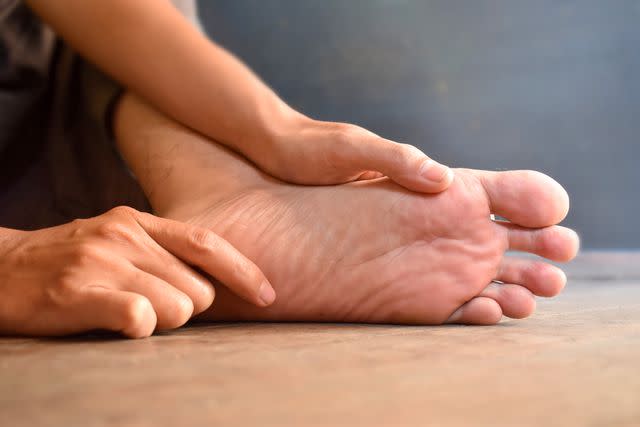9 Foot Pressure Points and Corresponding Benefits
Reflexology, or trigger point release, may restore internal balance

Zay Nyi Nyi / Getty Images
Medically reviewed by David Kesselman, DC
Reflexology practitioners use foot pressure points to offer relief for various conditions. Reflexology is a complementary therapy in which pressure is applied in one area of the body to benefit a corresponding area.
In traditional Chinese medicine (TCM), certain body parts are thought to be linked through pressure points, and reflexology offers relief by manipulating these pressure points in areas of the body that are difficult to access and treat.
This article will explore some potential benefits of foot reflexology, identify where pressure points on your feet are located, and offer ways to get started if you're interested in foot reflexology as a complementary treatment.

Zay Nyi Nyi / Getty Images
Where Are the Foot Pressure Points?
There are multiple pressure points in the feet, and each is believed to have a corresponding area in the body that may benefit from distant pressure or massage.
Below is a list of foot pressure points with the corresponding regions of the body these pressure points might be linked to.
Pressure Point | Body Region |
Tips of the toes | Head and brain |
Middle of the toes | Face and sinuses |
Base of the toes | Teeth, gums, and jaw |
Base of the pinky toe | Neck |
Outer side of the foot | Arms, elbows, knees, legs |
Inner side of the foot | Neck, brain stem, thymus, spine, and bladder |
Outer side of the ankle | Lower back |
Inner side of the ankle | Lymph glands, fallopian tubes, and groin |
Top, middle area of the foot | Lungs, chest, breast, and upper back |
Different areas on the soles of the feet are associated with specific internal organs that cannot be accessed during massages, such as the kidneys, spleen, and adrenal glands.
A general breakdown of the pressure points and corresponding body areas is as follows:
The top of the foot to the head
The ball of the foot to the chest
The arch area to the abdomen
The heel of the foot to the pelvic area
Some people may have more pressure points than others, or they can be located in slightly different areas. Finding the most effective foot pressure points for relief might take trial and error.
Self-Massages to Try
You can try reflexology on common areas of the foot that respond to pressure. You may need to try different locations, massages, and amounts of pressure to notice a benefit.
There are therapists who are trained in foot reflexology, but if you want to try massaging these areas on your own, apply pressure with a thumb or finger and then rub with small, concentrated movements. Foot reflexology should not cause pain, so don't push too hard. The pressure should feel similar to a foot massage.
Learn More:What Is Integrative Medicine?
Use in Traditional Chinese Medicine
Reflexology is one of the most commonly used complementary and alternative medicine (CAM) forms. It's been used for centuries in areas of traditional medicine. One study suggests that reflexology was first referenced in Chinese medicine about 5,000 years ago, and many other cultures have used forms of reflexology for thousands of years.
Reflexology is related to other therapies that use touch or pressure in different body areas for comfort or treatment of various conditions, including acupressure, acupuncture, and massage therapy.
Possible Clinical Benefits
Reflexology has several assumed benefits. However, there is limited evidence and clinical research to support the exact effect of this therapy.
Massage, pressure, and other forms of stimulation can increase blood supply, improve circulation, and help various substances move through the body. Sometimes referred to as a type of detoxification, reflexology is suspected to help remove calcium, lactate, and uric acid buildup in your tissues, which can cause problems.
The nerve impulse theory suggests that foot reflexology can stimulate nerve signals that correspond with responses in other body areas.
Foot reflexology has been studied as a therapy for some health conditions, including:
Sleep problems (e.g., insomnia)
Injury and illness recovery
Stress management
Some researchers have studied reflexology to support the management of conditions like diabetic neuropathy and multiple sclerosis, but the outcomes vary. Additionally, some people, like pregnant people or those sensitive to overstimulation, should avoid reflexology due to potential complications.
Reflexology research suggests that this therapy is most beneficial for relieving sleep problems, pain, and stress symptoms, especially in older adults. It may also reduce the medication required to manage chronic conditions like insomnia.
Where to Find Reflexology Practitioners
There is only one organization in the United States that officially certifies reflexologists. The American Reflexology Certification Board (ARCB) has a standardized continuing education and certification program and isn't affiliated with any one school or reflexology technique.
The ARCB offers a directory of practitioners who have met their certification criteria, plus additional information about obtaining a certificate. Other organizations also provide lists of reflexology practitioners, but these groups may only share networks or ethical standards rather than offering formal training or certification programs.
Summary
Several pressure points in your feet may be linked to different areas throughout your body, though scientific evidence is lacking to recommend this as a primary treatment. Traditional Chinese medicine practitioners have used these pressure points to offer treatment or relief of conditions or discomfort.
Reflexology is considered a complementary treatment option. If you are interested in trying foot reflexology, you can perform the exercises at home, or you can find a list of certified therapists in your area.

